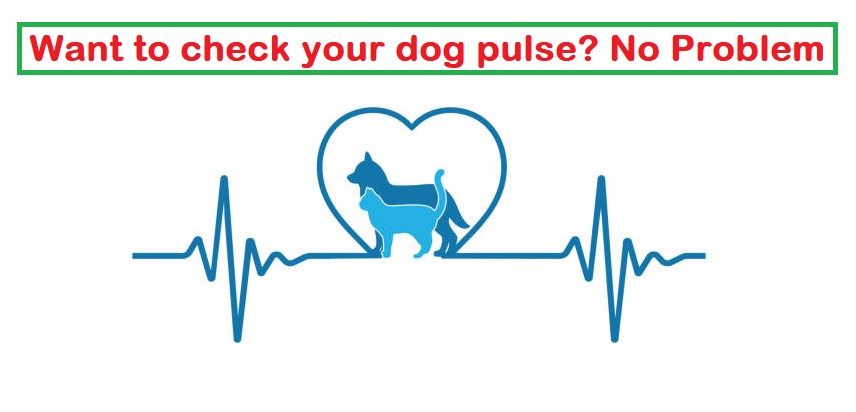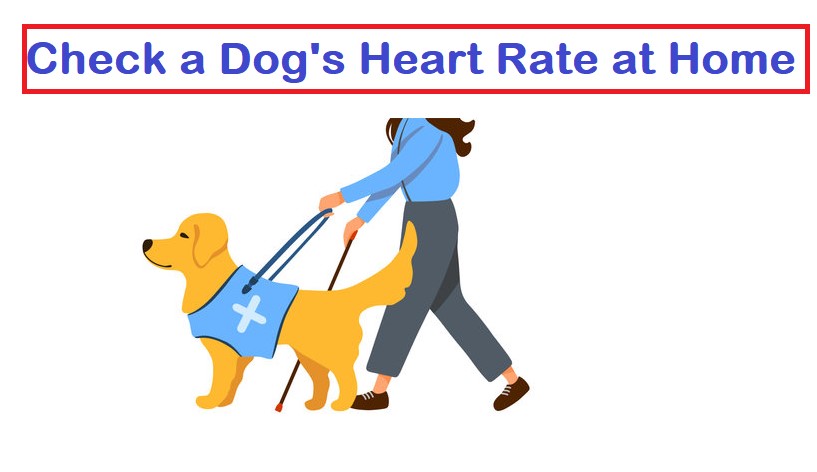Do you want to know how to check a dogs pulse? Pet owners need to know if your dog’s heart is beating at the right speed, especially when your dog seems unwell. When you visit the vet, they use a stethoscope to listen to your dog’s heart. But you can also check your dog’s pulse rate at home using just a stopwatch and your hand. You can do it by feeling their hind leg’s pulse. Count the beats in 15 seconds, then multiply by four for their heart rate.
In this article, we will try to explain what the pulse rate means, what is the normal dog pulse and how to use this skill to keep your dog healthy. Ready to learn and care for your four-leg friend?
You may like to read: Why Do Dogs Stretch? [8 Reasons]
How To Check A Dogs Pulse

Follow these steps to Check Pulse / Heart Rate in Dogs
Get the things you need
Before you begin, make sure you have the following supplies on hand
- A quiet and comfy place
- You can use a stethoscope (if you have one)
- A stopwatch or smartphone with a timer
- Be patient and stay calm
Ask your dog to stand up or lie on its side
You’ll be checking the pulse, so make sure you can reach the dog’s chest and belly.
Place your hand where a back leg connects the belly
The best spot to check your dog’s pulse is its femoral artery, at the top of its hind leg where it meets its belly.
- Put your fingers where the back leg meets the belly.
- Gently press with your fingers.
- If you don’t feel the pulse immediately, try moving your fingers around that area until you do.
- Your dog can stand or lie down while you do this.
Touch the dog’s chest to find its heartbeat

If you can’t find the femoral artery, try feeling for a pulse in your dog’s chest. Have your dog stand up, face them, and put your hand over their ribcage.
- Feel just below your dog’s elbow joint for the heartbeat.
- If that doesn’t work, place your hand on your dog’s left side, just behind the front leg.
- You might feel the pulse this way.
You may like to read: What Is A Dog Normal Temperature?
Find the pulse on your dog’s hind legs
If the other methods don’t work:
- Try feeling for a pulse on your dog’s back feet.
- Use your fingertips to touch the foot.
- Look for the pulse halfway between the toes and the ankle/wrist joint.
- This is known as the “pedal pulse.”
Counting the dog’s Pulse

You have two options to count your dog’s pulse
-
Using a stethoscope
Place the stethoscope over the femoral artery, listen for the heartbeat, and count the beats for 15 seconds. Multiply this number by 4 to get the beats per minute (BPM).
2. Without a stethoscope
If you don’t have a stethoscope available no problem. Follow these steps
Set a stopwatch for 15 seconds
- Heart rate is measured in beats per minute (BPM).
- Counting for a full 60 seconds can be tricky, so set a timer for 15 seconds.
- You can use a watch with a second hand or the stopwatch on your phone.
Count the beats
- Put your fingers on the chosen pulse area.
- Start your stopwatch.
- Count your dog’s heartbeats.
- Just use your fingers; don’t use your thumb, or you might feel your own pulse, especially if you press too hard.
Multiply by four
- To find the heart rate in beats per minute (BPM), take the number you measured.
- Multiply that number by four.
- For example, if you counted for 15 seconds, multiplying by four would give you the BPM for one minute (60 seconds).
Determine if the pulse is normal or not
It’s important to know your dog’s heart rate, but what’s normal depends on their size. Bigger dogs usually have a slower pulse. Here’s a general idea of what’s considered normal:
- Small dogs (under 20 pounds): Normal pulse is 70-180 beats per minute.
- Larger dogs (over 20 pounds): Normal pulse is 60-140 beats per minute.
- Puppies up to six weeks old: Their pulse can go up to 220 beats per minute.
- Some dogs might have a normal change in their pulse: It gets faster when they breathe in and slower when they breathe out. This is called “sinus arrhythmia.”
Seek veterinary help

If your dog’s heartbeat is too fast or too slow for its size, or if it feels weak or irregular, you should contact a vet right away. This might mean your dog has a serious health problem.
- A fast dog heart rate might mean your dog is anxious.
- If your dog’s pulse stays consistently fast, it could be a sign of problems like blood loss, dehydration, fever, or heatstroke.
- A slow heart rate could mean your dog is in shock or has heart disease.
- A slow pulse might also be due to a condition called sinus bradycardia, usually not serious but could be linked to neurological or respiratory issues and sometimes caused by being too cold.
- If you suspect heart problems, it’s crucial to seek immediate medical help, especially if your regular vet is unavailable.
You may like to read: Why Do Dogs Hide Their Treats? [Reasons & What to Do]
Factors Affecting Pulse
Several factors can temporarily affect your dog’s pulse, including:
- Exercise
- Anxiety or excitement
- Hot weather
- Illness or pain
- Medication side effects
Now you must have found how to check a dog’s pulse at home without a stethoscope. If you find your heartbeat abnormal contact a vet immediately. We have tried to cover every aspect of the topic, will look for more, and try to add that in the next update. How was the article? Let us know in the comment section below
FAQs: How to Easily Check the Heart Rate of a Dog

Still not satisfied? Here are some frequently asked questions:
What is the normal pulse for a dog?
A dog’s normal heartbeat depends on its size. Small dogs and puppies usually have heart rates of 120 to 160 beats per minute. Bigger dogs, over 30 pounds, typically have slower heart rates of 60 to 120 beats per minute. The larger the dog, the slower their normal heart rate.
What is a dangerously high heart rate for dogs?
A dangerously high heart rate for dogs varies, but if it consistently goes well, it is greater than 140 bpm in large dogs, 160 bpm in medium-sized dogs, 180 bpm in small dogs, or 220 bpm in puppies. it’s a cause for concern and needs urgent vet attention.
How do you check a dog’s heart rate?
To check your dog’s heart rate, put your hand on the left side of the chest and count how many beats you feel in 15 seconds. Then, multiply that number by four.
Do dogs have a pulse in their leg?
Yes, you can find the femoral pulse inside the leg around the groin area.
Why is my dog breathing fast?
This occurs when your dog gets too hot and loses water fast. It can make your dog breathe quickly without panting. Reasons can include injuries, muscle pain, or tummy issues. Fast breathing might also be due to problems like pneumonia, a lung tumor, or laryngeal paralysis.
How to check a dog’s heart rate with a stethoscope?
To check your dog’s heart rate, put your stethoscope on the left side of the chest and count how many beats you feel in 15 seconds. Then, multiply that number by four.
What is a dog’s sleeping heart rate?
Adult dogs, usually have a resting heart rate between 70 and 120 beats per minute.

